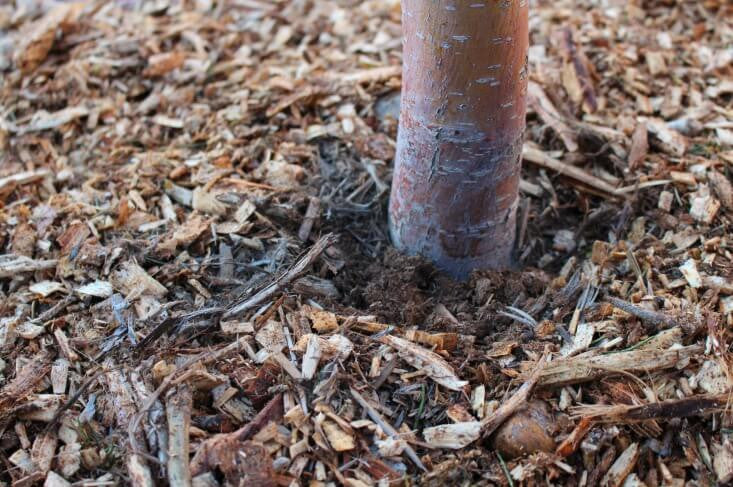
The Importance of Mulch for Your Living Memorial
Honoring a departed loved one with a living memorial is a beautiful way to hold them in everlasting remembrance. The Living Urn is a biodegradable urn (bio urn) designed to hold the cremains of a loved one, uniting them with a young tree of your choice. While the innovative design is complex, it’s quite easy to use. However, once your tree urn is planted, it needs to be nurtured in order to flourish and thrive for years to come. One critical element that supports the growth of trees is mulch.

Why is Mulch So Important for Your Tree Urn?
Mulch serves several vital functions in supporting the health and growth of your memorial tree. One of its primary benefits is insulation. By providing a layer of insulation, mulch creates a buffer against extreme temperature fluctuations, protecting the delicate root systems from both the heat of summer and the cold of winter. This temperature regulation is crucial, especially in the first few years of the tree's life, when it is most vulnerable to environmental stressors.
Another significant advantage of mulch is its ability to retain moisture in the soil. By reducing the evaporation rate, mulch ensures that the roots remain consistently moist, which is essential for the tree's growth and development. Consistent moisture levels help the tree establish a robust root system, making it more resilient to drought conditions.
In addition to moisture retention, mulch plays a crucial role in weed suppression. Weeds compete with young trees for essential nutrients, water, and light. By preventing weed growth, mulch minimizes this competition, allowing the tree to access the resources it needs to thrive. Also, the presence of mulch helps to prevent soil compaction. Loose, well-aerated soil allows roots to grow freely and absorb nutrients more efficiently, promoting healthier and stronger tree growth.
What is the Best Way to Add Mulch Around Your Memorial Tree?
Applying mulch correctly around your memorial tree is essential to maximize its benefits. Begin by removing all grass and weeds within a 3 to 5-foot radius around the tree. This cleared area will reduce competition for resources and create a designated space for the mulch.
Next, spread a generous layer of natural mulch, such as bark or wood chips, over the cleared area. Aim for a depth of 2 to 4 inches, ensuring that the mulch is evenly distributed. However, be careful not to pile the mulch directly against the tree trunk. Leaving a small gap around the base of the trunk helps prevent moisture buildup, which can lead to rot and other diseases. This gap also allows air to circulate around the trunk, promoting healthy bark.
Regularly check the mulch layer to ensure it remains at the appropriate depth. Over time, organic mulch will decompose and may need to be replenished to maintain its effectiveness. By following these steps, you can create an optimal environment for your memorial tree to flourish!
Organic vs. Inorganic Mulch – Which One is Best?
Choosing between organic and inorganic mulch involves considering the specific needs of your memorial tree and the local environment. Organic mulch, which includes wood chips, straw, bark chips, and grass clippings, is often recommended by arborists for several reasons.
Firstly, organic mulch decomposes over time, enriching the soil with humus. This natural decomposition process improves soil structure, increases nutrient availability, and enhances the tree's overall health. The gradual release of nutrients supports long-term growth and vitality.
Secondly, organic mulch excels in water retention. During hot, dry periods, it helps maintain soil moisture levels, reducing the need for frequent watering. This particularly benefits young trees that require consistent moisture to establish strong roots.
Also, organic mulch is highly effective at reducing weed growth. Blocking sunlight and creating a barrier inhibits weed germination and growth, minimizing competition for resources. This weed suppression allows the tree to access more nutrients and water, promoting healthier growth.
From an aesthetic perspective, many people prefer the natural appearance of organic mulch. It blends seamlessly with the landscape, creating a cohesive and visually appealing environment for your memorial tree. Also, organic mulch is often more affordable and readily available from local suppliers, making it a cost-effective choice for many gardeners.
However, organic mulch does have some disadvantages. It may blow away in windy conditions, and excessive moisture retention can sometimes lead to root rot if not monitored properly. Despite these drawbacks, the benefits of organic mulch generally outweigh the disadvantages, particularly for young trees.
Inorganic mulch, such as rocks, stones, plastic, and pieces of brick, offers an alternative option. While it does not decompose and thus does not enrich the soil, inorganic mulch is durable and long-lasting. It can be beneficial in areas where erosion control is a concern or in landscapes where a more permanent mulch solution is desired.
The Living Urn is America’s first and leading bio urn and planting system designed to grow beautiful memory trees with cremated remains. Our award-winning nursery offers over fifty types of trees and shrubs to help you honor your loved one beautifully. Simply enter your zip code to find the most suitable choices for your region. Whether you wish to plant a living memorial in your backyard, a Memory Forest, or another sacred spot, The Living Urn can help. Visit our store today to learn more!


